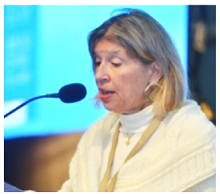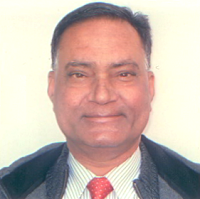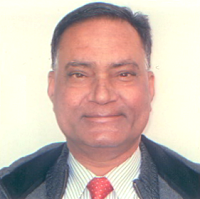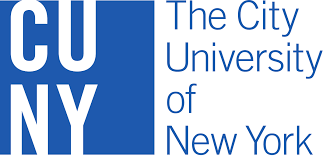Day 1 :
Keynote Forum
Robert Tuba
Hungarian Academy of Sciences, Hungary
Keynote: Synthesis of high value chemicals from renewable resources via isomerization metathesis (isomet)
Time : 10:00-10:45

Biography:
Abstract:
Keynote Forum
Marta Irene Litter
National Atomic Energy Commission, Argentina
Keynote: Current state of the art on green synthesis of iron-based nanoparticles: a case study of iron nanoparticles from Argentine Yerba mate and green tea extracts useful for removal of pollutants in soil and water
Time : 10:45- 11:30

Biography:
Abstract:
Keynote Forum
Niki Baccile
Sorbonne University, France
Keynote: Microbial biosurfactants, more than simple amphiphiles: From structure-property relationships to soft materials
Time : 11:45-12:30

Biography:
Abstract:
Keynote Forum
Alexander O Terent’ev
Russian Academy of Sciences, Russia
Keynote: Green synthesis of bioactive organic peroxides
Time : 12:30-13:15

Biography:
Abstract:
- Workshop on
Location: Andromede

Chair
Virinder Parmar
The City University of New York, USA
Session Introduction
Christophe Len
Chimie ParisTech - PSL University, France
Title: Recent advances and future projections on sustainable development for bio-based furan production

Biography:
Christophe Len has received his PhD in 1995 from the Université de Picardie Jules Verne followed by a Post-doctoral Fellow at the University of Hull (England). In 1997, he became Assistant Professor at UPJV and was promoted to full Professor in 2004 at the Université de Poitiers (France). In 2010, he moved as full Professor at the Université de Technologie de Compiègne - UTC (France) and in 2017, he developed his research in Chimie ParisTech (France). He has published almost 180 original publications and review articles, eight book chapters and nine patents. Among recent awards and recognition to his scientific career, he was promoted Honorary Professor of the University of Hull, England (2012-2018), Honorary Life Fellow of Indian Society of Chemists and Biologists (ISCB, 2014), Fellow of the Association of Carbohydrate Chemists and Technologist of India (ACCTI, 2015) and Fellow of the Royal Society of Chemistry (FRSC, 2015). In 2017, he has been honored with 2017 Glycerine Innovation Award sponsored by the American Cleaning Institute and the National Biodiesel Board. His current research explores organic chemistry and catalysis applied to biomass.
Abstract:
The concepts of sustainable development, bio-economy and circular economy are increasingly being applied to the synthesis of molecules of industrial interest. Among these molecules, furfural as a platform molecule is the subject of various research approaches to improve its synthesis and productivity, and also to extend its transformation for the production of molecules of interest. Due to the current momentum in promoting green chemistry for sustainable development, chemists have recently established catalytic reactions based on alternative technologies such as continuous flow. The present study showed recent breakthroughs obtained in the production of furfural, hydroxymethylfuran, methylfuran, methyl levulinate and g-valerolactone starting from lignocellulose in the presence of homogeneous catalysts and heterogeneous catalysts using either batch process or continuous flow process. Various reaction parameters in dependence of time such as temperature, catalyst and feedstock loadings as well as solvent types have been optimized. Conception, synthesis and physico-chemical properties will be detailed.
Virinder Parmar
The City University of New York, USA
Title: Biocatalytic synthesis of novel polymeric nanomaterials: Applications in Health and Industrial Sectors

Biography:
Virinder S Parmar has completed his BSc Honors, MSc and PhD from the University of Delhi (India), and has worked for nearly 10 years as a Post-doctoral/Visiting Scientist at Cornell University, Harvard University, University of Massachusetts Lowell (UML), NYU-Poly and MIT (USA); the University of Basel (Switzerland) and the Imperial College of Science, Technology and Medicine (London, UK). He is currently a Faculty member in the Department of Chemistry and Environmental Science at Medgar Evers College, The City University of New York (Brooklyn, New York, USA). He has been a Faculty at St. Stephen’s College and the University of Delhi (India) for 44 years, he was recently retired as Full Professor of Chemistry and has served as Head of the Department of Chemistry and as Chairman of the Board of Research Studies, and Provost of Gwyer Hall at this University. He has been an awardee of Medals for Excellence in Research from the Chemical Research Society of India (CRSI, Bangalore) for the year 2001 and of the Indian Society of Chemists and Biologists (ISCB, Lucknow) for the year 2009. He has been a recipient of the Academic Staff Award from the EXPERTS II Consortium of the European Union (EU) in December 2012 and April 2013. His research interests include: Green/Sustainable Chemistry, Nanotechnology, Organic Synthesis, Nucleic Acid Chemistry, Advanced Materials, Medicinal Chemistry, Biocatalysis and the Chemistry of Natural Products. He has delivered invited/plenary lectures at 147 international meetings and has given 398 research seminars at 293 Institutions in 31 countries across the globe. He is the Executive Editor of the Journal Biocatalysis and Biotransformation, and has been on the Editorial Boards of the Journals: ChemSusChem, Mendeleev Communications, Indian Journal of Chemistry, Natural Product Communications, Arkivoc, Molecules and ISRN Medicinal Chemistry. He is a regular reviewer for several journals published by the American Chemical Society, the Royal Society of Chemistry (London), Elsevier & Wiley-VCH, etc. and also a member of the IUPAC’s Subcommittee on Biomolecular Chemistry and the Interdivisional Committee on Green Chemistry for Sustainable Development (ICGCSD).
Abstract:
We have developed a chemo-enzymatic synthesis for obtaining novel amphiphilic polymeric nanoparticles based on PEG having a broad range of additional chemical functionalities under mild “greener” conditions. Simplicity and versatility of this method for the synthesis of highly functionalized amphiphilic polymeric nanoparticles with the advantage of “green appeal” further enhance its applications as an important strategy. These unique alternating copolymer micellar nanoparticles have been used successfully for the encapsulation of a large number of drugs of different classes and delivery vehicles targeted to human cancer cells expressing the underglycosylated mucin-1 antigen, which is found on almost all epithelial cell adenocarcinomas. The solubility of the chemotherapy drug doxorubicin increased by encapsulation in these nanoparticles, and cellular uptake, and hence cancerous cell death, was enhanced as compared to that with the free drug. The encapsulated taxol and doxorubicin showed significant enhanced activity against neuroblastoma cancer cells than anti-cancer drugs alone, and doxorubicin encapsulation showed three to six times better activity against pancreatic cancer cells. Nanospheres with different linker molecules such as naturally occurring aspartic acid and glutamic acid have also been prepared to assure non-toxic character of these nanomaterials and their biodegradability. The surface of these nanospheres is non-immunogenic as they are rich in PEG chains which do not interact with proteins. These polymers self-assemble in water to produce nanospheres with a typical diameter of 10-70 nanometers. Critical micelle concentration for these micelles is low (~0.25 millimolar). These materials are non-toxic; 60 g material per kg body weight can be tolerated. A novel nanotechnology platform for in vivo imaging and delivery of multifunctional therapeutics of cancer has also been designed based on perfluorinated amphiphilic copolymers. These nanoprobes are highly unique because of their ability to image and treat the cancer tumors by delivering the drugs to the cancer tumor sites. The methodology developed for the synthesis of perfluorinated copolymers is highly flexible and efficient. The in vitro and in vivo studies on these nanoprobes are in progress. Recently we have synthesized cationic polymers that constitute of guanidine functional groups and poly (ethylene glycol) units. Because of their strong basic character, guanidines are fully protonated under physiological conditions. The positive charge thus imposed on the molecule forms the basis for specific interactions between ligand and receptor or enzyme and substrate, i.e. as ammonium cations, they may bind to polyanionic DNA’s and also to negatively charged cell surfaces to trigger endocytosis. Thus they may serve as gene siRNA delivery vehicles in order to cure many hereditary diseases and treat acquired diseases resulting from either multigenic disorders or foreign viral genes. The bio-derived non-crystallizable polymeric materials were used in formulating quasi-solid electrolyte compositions and incorporated into flexible dye-sensitized titanium oxide solar cells (DSSC). It was observed that the solar conversion efficiency of quasi-solid electrolytes incorporated solar cells depends strongly on the polymer microstructure used in formulating the redox electrolyte and our polymeric materials showed photovoltaic efficiency of up to 9%. Further, highly useful novel, non-toxic “environment-friendly” non-halogenated flame retardant organo-silicone polymeric materials using the above environmentally benign “green” biocatalytic technologies have been developed. These show superior properties than commercial flame retardant materials. These results shall be presented in the talk.
Michele Vittadello
The City University of New York, USA
Title: Cytochrome c oxidase oxygen reduction induced by Cytochrome c onto nickel coordination surface based on graphene oxide in suspension

Biography:
Michele Vittadello has received his PhD in Chemical Sciences in 2003 from the University of Padua in Italy with Dr. Vito Di Noto. He spent two years (2003-2005) as a Post-doctoral Fellow in the lab of Dr. Steve Greenbaum at the City University of New York - Hunter College. He was a Post-doctoral Research Associate in the Materials Science and Engineering Department at Rutgers, The State University of New Jersey (2005-2008). While at Rutgers, he was awarded funding by the Rutgers Energy Institute (2007-2008). He is primarily interested in the investigation of fundamental physical-chemical properties of nanomaterial, biomaterials and materials with potential applications in the fields of energy storage/generation, biotechnology and radio-remediation. In the Fall of 2008, he joined the faculty at CUNY - Medgar Evers College as an Assistant Professor of Chemistry and was promoted to Associate Professor with tenure in the Fall 2015. He has held visiting positions at Rutgers University (Department of Chemistry) and Princeton University (Department of Chemistry). His work appeared in several articles published in international journals such as J Phys Chem, Macromol Chem and Phys, Electrochimica Acta, Journal of the Electrochemical Society, Solid State Ionics, J. Power Sources, Inorganica Chimica Acta, ChemSusChem, and Carbon.
Abstract:
In vitro investigations on isolated components of the mitochondrial electron transport chain are expected to shed new light on the plethora of bioenergetic functions carried out by mitochondria, affecting the performance of living organisms. This study is focused on assessing the biocompatibility of graphene oxide (GO) derivatives with His-tagged cytochrome c oxidase (CcO), expressed and purified from Rhodobacter sphaeroides using the Gibson assembly method. As prepared GO was enriched with carboxylic acid groups yielding carboxylated GO (CGO). CGO was functionalized with nitrilotriacetic acid (NTA) yielding CGO-NiNTA, in the presence of Ni2+ ions. We investigated the reaction of horse-heart cytochrome c (Cyt c) with free CcO and CGO-NiNTA-CcO coordination complexes in suspension. Kinetic studies by UV-Visible absorption spectroscopy confirmed that free CcO oxidizes Cyt c and provided a similar indication for immobilized CcO. However, oxygen-consumption measurements using a Clark-type electrode suggested that CGO-based supports are capable of oxygen reduction reaction (ORR), especially in the presence of Ni2+ coordination centers. The ORR caused by immobilized CcO could be clearly distinguished from that of CGO-NiNTA in the presence of Cyt c and dithiothreitol (DTT) as a sacrificial reducing agent. The results indicate that while the protein content is about 3% by mass with respect to the support, the contribution to the oxygen consumption activity ranges from 39.3% to 71.0%, depending on the concentration of DTT. This finding indicates that the support stabilizes the free enzyme which, while capable of Cyt c oxidation, is unable to carry out oxygen consumption in solution. The turnover rate was as high as 599 O2 molecules per CcO unit per second.


